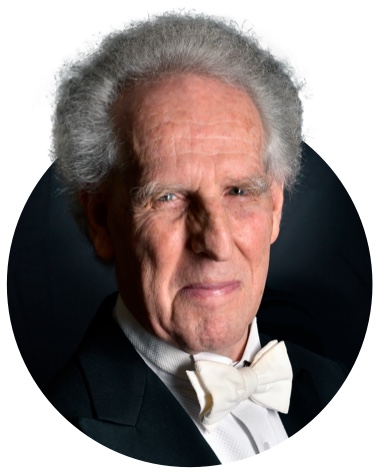Brahms: Symphony no. 2
Brian Bell (interviewer)

“However gloomy you are, at the end of the Brahms 2nd, you have to be full of joy.”
— Benjamin Zander

Transcript:
Brian Bell:
Now, one of my grand frustrations is that I don’t have a handy list of what you’ve done over these past 30-plus years. But my gut is telling me that you’ve ended more than a few seasons with the Brahms 2nd. That this is kind of a summing up of a season, a summing up of a year. You don’t finish a season with the Brahms 4th, but you don’t hesitate to finish it up with the Brahms 2nd. What is going on here? What am I picking up here?
Ben Zander:
Well actually, if I go back right to the beginning of my conducting life, which was 38 years ago, not 30 years ago, the very first concert I conducted ended with the Brahms 2nd. And so it is the beginning of my life, and fortunately not the end, but this median point after 38 years, come back to the Brahms 2nd. It is one of the most radiant pieces of music that has ever been written. It has joy and openness and freedom and light and a nobility, a warmth, a spaciousness that is irresistible. And the less one says about it, in a way, the better. Because although it appears… He composed it during the summer months in a small village in Austria. And he said, “There were so many tunes around there that you had to be careful you didn’t tread on them.” And so the tunes come with immense ease in this music.
However, it is also one of the most tightly constructed piece of music he ever came up with. In that sense, it’s the ultimate masterpiece, a piece that is written with intellectual rigor, almost unheard of in any other composer. And it sounds as though it’s being composed on the spot, improvised is the word. And that’s the miracle of the Brahms 2nd. It’s the ease and the love. Orchestra players adore to play it. And what we have brought to this piece, and again, this is something I’ve been exploring for a full 30 years, is the idea that this music can be played with immense freedom of timing, the timing of folk music, the timing of language. So that instead of being stuck again, the same thing as in the Orozco, instead of being stuck, the theme incidentally, very similar in the horns. It’s a horn theme.
Brian Bell:
And really relatively few symphonies are in 3/4, for its movement.
Ben Zander:
Yeah. But it actually isn’t in 3/4, it’s in 4/4. It’s in 4, like most music. In other words, each bar is a beat. And I conduct it in 4. I conduct the second bar to the left and the third bar to the right, and the fourth bar as if I was conducting one large 4-bar phrase. And it works perfectly and beautifully, and it gives the freedom to the players. So that’s subdominant, that beautiful chord, so heavenly that they feel that needs a little time, and they can take the time. If you lay down each beat, unfortunately, you can’t have that.
Brian Bell:
Well, the cross rhythms get too aggressive, I think. Yes?
Ben Zander:
Yeah, yeah. So that’s a secret. And the second movement is actually very dark, full of sadness, and the darker side of it. And that, of course, tragic, beautiful writing for cello and the trombone. And incidentally, the tuba. The only symphony in which the tuba appears. Not only of Brahms, but Beethoven never used the timpani or the tuba. And nobody used the tuba until Brahms in the 2nd symphony. And the reason is because of that deep resonance, almost like an organ, those great chorals in the brass with the low tuba sound. And it’s an uncannily beautiful sound. And in the second theme of the first movement, that’s a Liebeslieder waltz, that’s a waltz of love. And he’d written many of them for four hands and voices.
And so he took all those different kinds of music, chamber music songs, put it all in the symphony. And the third movement is entirely a song. It’s a beautiful song for oboe. Where again, the complement follows that free melody. And it is a miracle of the third movement, because it has not only that minuet, but another two, almost like a Russian doll where they fit in. It’s all in one tempo, but it goes from an andante to a allegro molto to a presto, all in the same tempo, by shifting the beat. It’s kind of a miraculous piece of mathematics, beautifully done. And all you can do is just smile at the art and at the tenderness of it all.
And the last movement, which incidentally begins with the same three notes as the piece, which is like a motto theme for the whole symphony. If you listen, you can hear it throughout the symphony. But it begins with that. But it’s just a brilliant piece of virtuosity of the heart. And at the end, the joy of the trombones, nothing like that had happened in music up until that point. And the triumph, the trumpet, and the D major glory, I mean, it’s impossible to resist that joy. I mean, however gloomy you are, at the end of the Brahms 2nd, you have to be full of joy.